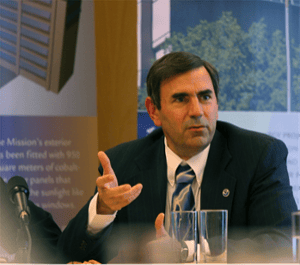 Dr. Thomas R. Karl. Photograph: Eric Bridiers/U.S. Missions.
Dr. Thomas R. Karl. Photograph: Eric Bridiers/U.S. Missions.As humans emit more greenhouse gases like carbon dioxide into the atmosphere, the Earth continues to warm. When I use the term “warm”, I mean there is an increase in thermal energy (heat) contained in the oceans and atmosphere of this planet.
We can measure warming by measuring temperatures; however, obtaining an accurate reading of the Earth’s temperature is complicated. Temperatures change with seasons, with locations, and there are natural long term variations that move heat around. So, we don’t expect temperatures just to continue increasing at all locations and at all times. We do expect the long term trend to be upwards, however, and that is what we’ve observed.
But if you follow the conversation about global warming, and particularly if you listen to cable news or online bloggers, you might have heard that there has been a hiatus or a halt to global warming. I’ve written before on this site that there is no halt, there never has been one. However there has been a vigorous debate about whether the increase in lower atmosphere temperatures has slowed down.
A new paper, “Possible artifacts of data biases in the recent global surface warming hiatus” just published today in Science deals with this issue. In particular, the lead researcher Dr. Thomas Karl and his colleagues investigate the quality of the near-surface temperature records and ask whether they really show a slowdown.
 Dr. Thomas R. Karl. Photograph: Eric Bridiers/U.S. Missions.
Dr. Thomas R. Karl. Photograph: Eric Bridiers/U.S. Missions.
The scientists make a number of improvements upon existing information. First, they focus on ocean surface temperature measurements from floating buoys and from ship-board sensors. We know that temperatures measured by ship sensors are often warmer than temperatures measured by buoys, in part because of the heat generated by the ship engine. A more thorough accounting of this effect has been implemented in the Extended Reconstructed Sea Surface Temperature data set version 4. This accounting is utilized in the paper.
Second, there has been a historical change in how ships measure surface temperatures. Decades ago, temperatures were mainly measured by insulated buckets. Around the time of World War 2, there was a change from insulated buckets to temperature sensors contained within ship hulls. The ship hull sensors recorded warmer water temperatures compared to the bucket method. A more thorough handling of the changes from buckets to ship hull sensors was also included in the new paper.
Finally, the new study used more recent estimates of the land temperatures. The new estimates combine multiple temperature databases into a single integrated whole.
The end result is that the temperature trends over the past 17 or so years has continued to increase with no halt. In fact, it has increased at approximately the same rate as it had for the prior five decades. But the authors went further by trying to cherry-pick the start and end dates. For instance, they stacked the cards against themselves by purposefully picking a very hot year to start the analysis and a cool year to terminate the study (1998 and 2012, respectively). Even this cherry-picked duration showed a warming trend. Furthermore, the warming trend was significant.
I asked lead author Dr. Karl for his comments on the significance of the paper and he told me,
Posted by John Abraham on Friday, 5 June, 2015
 |
The Skeptical Science website by Skeptical Science is licensed under a Creative Commons Attribution 3.0 Unported License. |